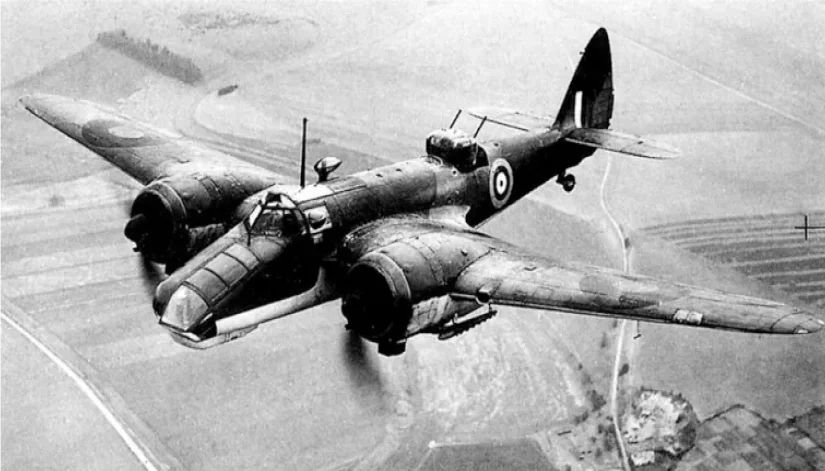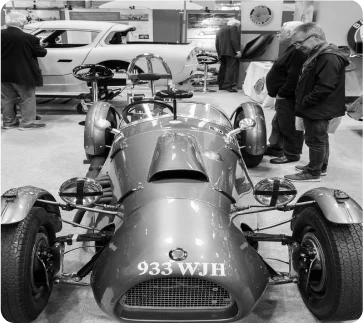THE CARS
History of the bristol marque

During two World Wars the firm produced large numbers of successful aircraft including the Brisfit (short for Bristol Fighter). The Bristol Blenheim(shown left) was introduced to Royal Air Force service in 1937, and its younger sister by just one year, the Bristol Beaufighter, was introduced to RAF service in 1938.
On the aero engine side, the company took over the Fedden designed Jupiter radial engine when it acquired Cosmos Engineering in 1921, and from it produced a series of brilliant engines including the Pegasus, Mercury, and the mighty Centaurus.The Olympus was a later development, designed originally for the Vulcan Bomber.It was later fitted with re - heat and is used to great effect, powering Concorde at multi sonic speeds, whilst the Marine version is fitted in many Royal Navy Warships.
One of the more unusual looking Bristol Aircraft produced, but nevertheless remarkably effective, was the Bristol Freighter.Developed originally to British Air Ministry specification as a Military Equipment Transporter, it was coded the Type 170. It was in contest with the Blackburn Beverley developed to meet exactly the same criteria, which became the favoured choice of the Royal Air Force.
Nevertheless, the Type 170 proved extremely reliable and was adopted by many countries, thus becoming a valuable export design and foreign exchange earner.The Royal New Zealand Air Force equipped their service with this as the favoured transport aircraft.This illustration is of the only known remaining civilian example kept in flying condition and now earns its keep in its home territory, Canada, where it regularly notches up as many as 8 cargo trips per day providing a reliable local service for a mining company in the Yukon territory.
These early “Guppy style” transporters also found extended life in civilian spheres of aircraft operation: amongst other airlines, Silver City Airways employed them to take freight or cars and their passengers from the South Coast of England to France on a regular two way cross Channel shuttle service.Such Aircraft provided a high speed cargo route across the Channel.These aircraft were economic enough to provide scheduled transport services for many years through to the late 60 s.Another picture of this rather strange looking “bird”, properly disgorging its Bristol cargo, is to be seen later on the Type 406 page.
At the end of WW2, Bristol, like other aero engineering and manufacturing industries, possessed a huge surplus of skilled labour and were faced with the need to find some alternative products until a new aeroplane market emerged.A move into the quality car market was agreed, and to this end the rights had been acquired in respect of the BMW pre - war car models and engines as war reparation.Thus in a remarkably short space of time, by developing from existing designs, the newly formed 'Car Division' was ready for series production, and by the autumn of 1946, motoring journals carried road tests of the Type 400 Saloon, a 2 - litre engined Bristol. This set new standards for performance, economy and comfort, and soon gained a formidable reputation in international motoring events as well as a respectable slice of the quality car market— and this despite being further constrained initially by the requirement that in order to qualify for vital raw material resources, 50 % of the production was destined to be exported.
Organizational changes took place, first in 1956 when the Car Division became a wholly owned subsidiary of the parent company, and later in 1960 when it was saved from oblivion by the late Sir George White and Mr Anthony Crook.Sir George's family had founded the British and Colonial Aeroplane Company in 1910(the change to Bristol Aeroplane Company occurred in 1920.
Thus in 1960 Sir George White and Mr Anthony Crook formed a new Company – Bristol Cars Limited – and thus the manufacture of Bristol cars was to continue, still then remaining within the Filton complex near Bristol. In 1966 the status of the Company was changed from that of a limited company to that of a firm in private partnership. When Sir George White retired in 1973, Mr Anthony Crook bought over Sir George's share and became the sole proprietor and Managing Director. At that point he changed the Company status back to that of a limited company. He remained sole owner into the mid 1990s. The company now has some new management associates with Mr Crook still at the controls and it continues producing cars to meet the orders for the very popular current model.
Want to know more?
We’re always happy to make new friends, so if you’d like discover the benefits of becoming a member today, read a little more about our membership.

